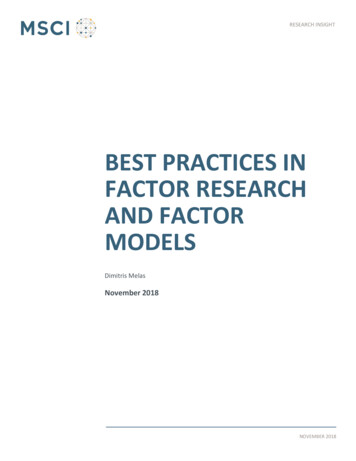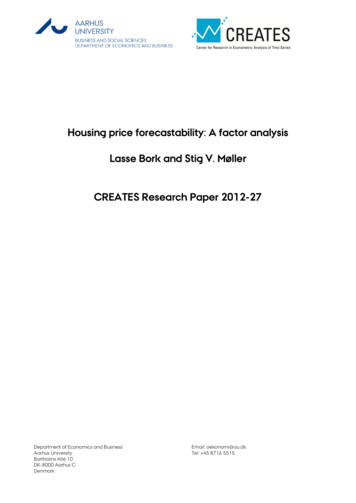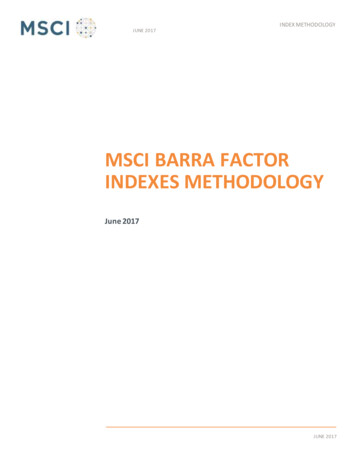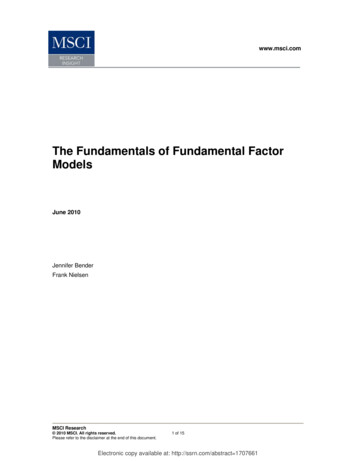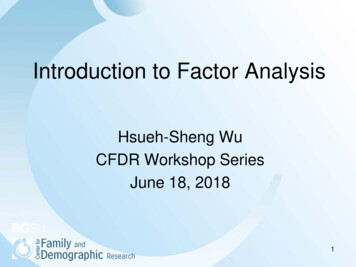
Transcription
Introduction to Factor AnalysisHsueh-Sheng WuCFDR Workshop SeriesJune 18, 20181
Outline Why do sociologists need factor analysis?What is factor analysis?Sternberg’s triangular love theorySome data questionsTypes of factor analysisSteps of conducting exploratory factor analysisSteps of conducting confirmatory factor analysisExtension of confirmatory factor analysisConclusion2
Why Do Sociologists Need Factor Analysis? Most social phenomena of interest are multi-dimensionalconstructs and cannot be measured by a singlequestion, for example:– Well-being– Violence When a single question is used, the information may notbe reliable because people may have differentresponses to a particular word or idea in the question. The variation of one question may not be enough todifferentiate individuals. Factor analysis is a data reduction tool that helps decidewhether and how the information of these questionsshould be combined to measure a construct.3
What Is Factor Analysis? Factor analysis is a statistical method that identifies alatent factor or factors that underlie observed variables. Specifically, factor analysis addresses the followingquestions:– How many latent factors underlie observed variables?– How are these latent factors related to observed variables?.– What do these factors mean? Factor analysis helps answer the question of howaccurate the sum of variables measure the latent factoror factors.4
Sternberg’s Triangular Love Theory Sternberg’s triangular love scale (45 items) measuresthree components of the love: passion, intimacy,commitment.Table 1. Sternberg’s Triangular Love TheoryType of LovePassionInfatuationxLikingIntimacyxEmpty LoveRomantic LoveCommitmentxxCompanionate LovexxFatuous LovexConsummate Lovexxxxx5
Sternberg’s Triangular Love TheoryTable 2. Description of 9 Variables Measuring LoveDimension# VariableDescriptionPassion1 thinkingI find myself thinking about "X" frequently during theday.2 attractive I find "X" to be very personally attractive.Intimacy3 companyI would rather be with "X" than with anyone else.1 sharingI am willing to share myself and my possessions with "X."2 closeness I feel close to "X."Commitment3 trustI feel that I can really trust "X."1 maintainI am committed to maintaining my relationship with "X."2 stabilityI have confidence in the stability of my relationship with"X."3 lastingI expect my love for "X" to last for the rest of my life.6
Conceptualization and Operationalization ofSternberg’s Triangular Love sharing closenessCommitmenttrustmaintainstabilitylasting7
Some Data Questions We know that these 9 items should be used tomeasure love. However, we still need to answerseveral data construction questions:(1) Do these 9 items also measure someconstructs other than love?(2) Should each of these 9 items be weightedequally in measuring love? Factor analysis helps address these twoquestions.8
Two Hypothesized Factorial Modelsof the Love MeasuresModel 1:Lovethinkingattractive companysharingcloseness trustmaintainstabilitylasting9
Two Hypothesized Factorial Modelsof the Love MeasuresModel 2:ConsummateLovethinkingattractive companysharingCompanionateLovecloseness trustmaintainstabilitylasting10
Types of Factor Analysis Exploratory Factor Analysis (EFA)– EFA examines (1) how many factors a measure estimates and (2) whatthese factors are.– EFA is used when an old phenomenon is re-conceptualized or a newphenomenon emerges .– SAS, SPSS, Stata, AMOS, LISREL, and Mplus all can conduct EFA. Confirmatory Factor Analysis (CFA)– CFA examines whether the number of latent factors, factor loadings, factorcorrelations, and factor means are the same for different populations or forthe same people at different time points.– CFA is used when the factorial structure of the measures has beenestablished.– SAS, Stata, AMOS, LISREL, and Mplus all can conduct CFA .– CFA is a more powerful technique than EFA because CFA allowsresearchers to test their hypotheses about the factorial structure ofobserved variables.11
Steps of Conducting Exploratory FactorAnalysisStep 1. Examine the 3.619128Std. 111115555512
Steps of Conducting Exploratory FactorAnalysisStep 2. Identify the number of factors underlying theseitemsfactor thinking-lasting, pf(obs 583)Factor analysis/correlationMethod: principal factorsRotation: (unrotated)Number of obs Retained factors Number of params .000013LR test: independent vs. saturated:chi2(36) 2677.62 Prob chi2 0.0000
Factor loadings (pattern matrix) and unique 41690.39340.48220.54980.45380.27530.420214
Steps of Conducting Exploratory FactorAnalysisStep 3. Understand what these factor meansrotate, varimax horst blanks(.3). rotate, varimax horst blanks(.3)Factor analysis/correlationMethod: principal factorsRotation: orthogonal varimax (Kaiser on)Number of obs Retained factors Number of params .96446.0.44790.44190.23620.44790.88981.1260LR test: independent vs. saturated:chi2(36) 2677.62 Prob chi2 0.000015
Rotated factor loadings (pattern matrix) and unique 0.42020.32580.31790.58430.5857(blanks represent abs(loading) .3)Factor rotation 8816estat commonCorrelation matrix of the varimax rotated common actor310010116
Steps of ConductingExploratory Factor Analysisrotate, promax horst blanks(.3)Factor analysis/correlationMethod: principal factorsRotation: oblique promax (Kaiser on)Number of obs Retained factors Number of params 153.515663.389600.75270.75000.7231LR test: independent vs. saturated:583324Rotated factors are correlatedchi2(36) 2677.62 Prob chi2 0.0000estat common17
Steps of ConductingExploratory Factor AnalysisRotated factor loadings (pattern matrix) and unique 220.54980.45380.27530.4202(blanks represent abs(loading) .3)Factor rotation 493218
Steps of Conducting Exploratory FactorAnalysisestat commonCorrelation matrix of the promax(3) rotated common actor31.583.68191.6606119
Confirmatory Factor Analysis Confirmatory Factor Analysis (CFA) is more powerfulthan Exploratory Factor Analysis (EFA). CFA can check the validity and reliabilty of themeasures. CFA examines whether the underlying factorialstructures are the same across different populations oracross different time points. Any SEM software can estimate CFA.20
Graphs and Parameters in SEM21
Jargon of SEM Variables in SEM– Measured variable– Latent variable– Exogenous variable– Error– Disturbance 8 sets of parameters22
Steps of Conducting of ConfirmatoryFactor AnalysisStep 1: Create a path diagram depicting thefactorial structure underlie the measuresStep 2: Fit the factorial structure to the dataStep 3: Examine the goodness of fit index andmodification indexStep 4: Consider what types of changes can bemade to fit the data betterRepeat the steps 2 through 4.23
Confirmatory Factor AnalysisModel 1: A Factorial Model Based on Sternberg’s TheoryDA NI 10 NO 600 MI 9RA FI 'D:\factor\factor.txt'LAthink attract company sharing close trust maintain stable lastingSE 1 2 3 4 5 6 7 8 9/MO NY 9 NE 3 LY FU,FI PS SY,FR TE DI,FRFR LY 1 1 LY 2 1 LY 3 1FR LY 4 2 LY 5 2 LY 6 2FR LY 7 3 LY 8 3 LY 9 3FI PS 1 1 PS 2 2 PS 3 3LEPassion Intimacy commitPDOU SE TV RS ND 3 MI24
Model 1: A Factorial Model Based on Sternberg’sTheory25
Confirmatory Factor AnalysisModel 2: Allow Stability to Be Loaded onto the Passion FactorDA NI 10 NO 600 MI 9RA FI 'D:\factor\factor.txt'LAthink attract company sharing close trust maintain stable lastingSE 1 2 3 4 5 6 7 8 9/MO NY 9 NE 3 LY FU,FI PS SY,FR TE DI,FIFR LY 1 1 LY 2 1 LY 3 1 LY 8 1FR LY 4 2 LY 5 2 LY 6 2FR LY 7 3 LY 8 3 LY 9 3FI PS 1 1 PS 2 2 PS 3 3LEPassion Intimacy commitPDOU SE TV RS ND 3 MI26
Model 2: Allow Stability to Be Loaded onto thePassion Factor27
Confirmatory Factor AnalysisModel 3: A Two-factor ModelDA NI 10 NO 600 MI 9RA FI 'D:\factor\factor.txt'LAthink attract company sharing close trust maintain stable lastingSE 1 2 3 4 5 6 7 8 9/MO NY 9 NE 2 LY FU,FI PS SY,FR TE DI,FRFR LY 1 1 LY 2 1 LY 3 1 LY 4 1 LY 5 1 LY 6 1 LY 7 1 LY 8 1 LY 9 1FR LY 4 2 LY 5 2 LY 6 2 LY 7 2 LY 8 2 LY 9 2FI PS 1 1 PS 2 2LEPassion Intimacy commitPDOU SE TV RS ND 2 MI28
Model 3: A Two-factor Model29
Two Hypothesized Factorial Modelsof the Love MeasuresModel 1: Second-order Factor psi1LoveIntimacypsi2Commitpsi330
A Multiple indicators and MultipleCauses (MIMIC) si331
Multiple Group Comparison The factorial Model for oveIntimacypsi2Commitpsi332
Multiple Group Comparison The factorial Model for 1LoveIntimacypsi2Commitpsi333
Conclusion Factor analysis is a statistical technique to understand what factorsunderlie observed variables Factor analysis is closely related with the measures of validity andreliability. CFA is more powerful than EFA. With EFA and CFA, researcherscan explore what has been measured, but only with CFA,researchers can fully test their hypotheses about the factorialstructure of the measure Although modification index can hint on how to modify your models.You should remember that model modification should also beguided by the theory. If you encounter problems running factor analysis, please contactme at wuh@bgsu.edu34
Jun 18, 2018 · Steps of Conducting Exploratory Factor Analysis Step 1. Examine the data sum . lasting 596
